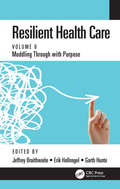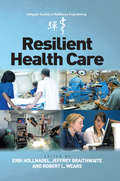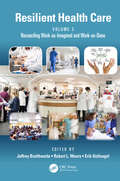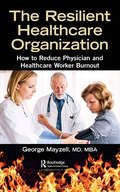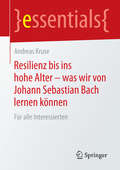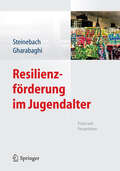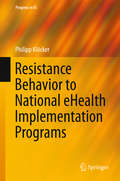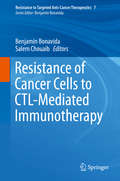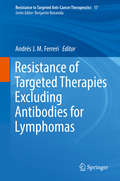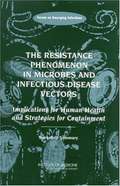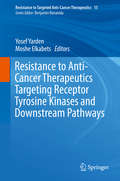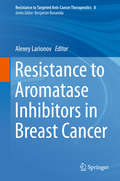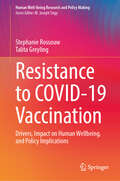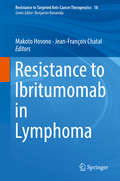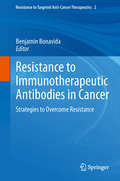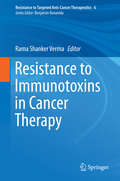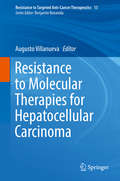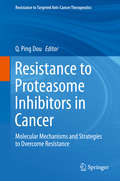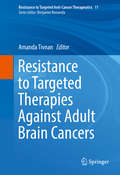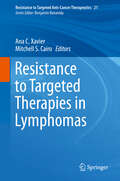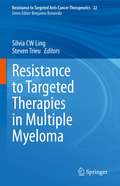- Table View
- List View
Resilient Health Care: Muddling Through with Purpose, Volume 6 (Ashgate Studies In Resilience Engineering Ser.)
by Jeffrey Braithwaite Erik Hollnagel Garth HunteThis book promotes an understanding of the purposeful muddling that health care workers rely on to be better able to function and operate in the multitude of complex ecosystems we call "health care". The book argues the case for the importance of recognising and understanding muddling behaviours, practices and activities in order to create resilient care. The book demonstrates how resilient health care principles can enable managers as well as those on the frontlines to work more effectively towards interdisciplinary care by gaining a deeper understanding of real-world practices that manifest in everyday clinical settings. This is done by presenting a set of case studies, theoretical chapters, and applications that relate experiences, bring forth ideas, and illustrate practical solutions. Primarily aimed at people who are directly involved in the running and improvement of health care systems, it provides practical guidance. It is also of direct interest to health care professionals in clinical and managerial positions as well as researchers.
Resilient Health Care: The Resilience Of Everyday Clinical Work (Ashgate Studies in Resilience Engineering)
by Erik Hollnagel Jeffrey BraithwaiteHealth care is everywhere under tremendous pressure with regard to efficiency, safety, and economic viability - to say nothing of having to meet various political agendas - and has responded by eagerly adopting techniques that have been useful in other industries, such as quality management, lean production, and high reliability. This has on the whole been met with limited success because health care as a non-trivial and multifaceted system differs significantly from most traditional industries. In order to allow health care systems to perform as expected and required, it is necessary to have concepts and methods that are able to cope with this complexity. Resilience engineering provides that capacity because its focus is on a system’s overall ability to sustain required operations under both expected and unexpected conditions rather than on individual features or qualities. Resilience engineering’s unique approach emphasises the usefulness of performance variability, and that successes and failures have the same aetiology. This book contains contributions from acknowledged international experts in health care, organisational studies and patient safety, as well as resilience engineering. Whereas current safety approaches primarily aim to reduce or eliminate the number of things that go wrong, Resilient Health Care aims to increase and improve the number of things that go right. Just as the WHO argues that health is more than the absence of illness, so does Resilient Health Care argue that safety is more than the absence of risk and accidents. This can be achieved by making use of the concrete experiences of resilience engineering, both conceptually (ways of thinking) and practically (ways of acting).
Resilient Health Care, Volume 3: Reconciling Work-as-Imagined and Work-as-Done (Ashgate Studies In Resilience Engineering Ser.)
by Jeffrey Braithwaite Erik Hollnagel Robert L. WearsThis book is the 3rd volume in the Resilient Health Care series. Resilient health care is a product of both the policy and managerial efforts to organize, fund and improve services, and the clinical care which is delivered directly to patients. This volume continues the lines of thought in the first two books. Where the first volume provided the rationale and basic concepts of RHC and the second teased out the everyday clinical activities which adjust and vary to create safe care, this book will look more closely at the connections between the sharp and blunt ends. Doing so will break new ground, since the systematic study in patient safety to date with few exceptions has been limited.
The Resilient Healthcare Organization: How to Reduce Physician and Healthcare Worker Burnout
by George Mayzell, MD, MBAProfessional burnout is an epidemic in America. Approximately half of physicians and nurses are affected and at risk for themselves and their patients. Much has been written about professional burnout. The term was originally coined in the 1970s by American psychologist Herbert Freudenberger to describe the consequences of severe stress and high ideals experienced by people working in "helping" professions. Since then, many books have been written to address this looming national public health crisis. But, unfortunately, there has been much less written from a solution standpoint: getting to the root cause of why this is occurring now more than ever. The Resilient Healthcare Organization engages readers focusing on physicians and healthcare professionals and their experiences and how they overcame a loss of enthusiasm for work, feelings of cynicism, and a low sense of personal accomplishment. The feelings of emotional exhaustion are characterized by depersonalization and perceived ineffectiveness. These are the cardinal features that define "burnout" and affect almost 50% of physicians and 30–70% of nurses. This book addresses why burnout is viewed as a threat and how it can be fought. The author discusses the contributing factors and solutions at the health system and societal level. Additionally, this book explores the current and future etiology and impacts on physicians and healthcare professionals, with a significant emphasis on solutions at both the individual level and the system level. Contributors: Patricia S. Normand MD, Bruce Flareau, MD, Kathleen Ferket, MSN, APRN, Daniel Edelman, DO, and Peter B. Angood, MD.
Resilient Urban Environments: Planning for Livable Cities (Cities and Nature)
by Runming YaoThis book aims to provide evidence of the impact of climate change and urbanization on cities’ urban environments thus on human health and wellbeing; and principles and methods for the improvement of the resilience of a city to extreme weather and long-term climatic changes through case studies. The book will have three themes of 1) Understanding the adverse environmental impact on human health and wellbeing; 2) analysis of adaptation and mitigation measures through modeling technologies; 3) providing best practice examples of the implementation of the proposed measures. The book will present the liveable cities including factors affecting liveability; ecological and biophilic city; economic values; health and well-being and opportunities for people. Physical and social health will be an important issue in the context of resilient cities. The widespread concerns will be addressed including physical and mental health; wellbeing in terms of building use;building surroundings and Biophilia; location in the context of sustainability and work-life balance; and spatial scale and community.
Resilienz bis ins hohe Alter - was wir von Johann Sebastian Bach lernen können: Für alle Interessierten (essentials)
by Andreas KruseDie Biografie Johann Sebastian Bachs wird unter dem Gesichtspunkt der Resilienz betrachtet: Wie ist es dem großen Komponisten gelungen, trotz zahlreicher Verluste, Rückschläge und Grenzsituationen sein außerordentliches schöpferisches Potenzial zu entfalten? Inwieweit sind Bezüge zwischen der Entwicklung in verschiedenen Lebensabschnitten und einzelnen Werken erkennbar? Lässt sich das Leben Bachs selbst als ,,Werk" interpretieren? Nach einem Überblick über psychologische Resilienzforschung werden der frühe Verlust seiner Eltern, der Tod seiner ersten Frau und die von gesundheitlichen Einschränkungen und dem Verlust der Sehfähigkeit geprägte letzte Lebensphase Johann Sebastian Bachs untersucht. Dabei wird deutlich, dass es ihm bis ans Ende seines Lebens gelungen ist, sein schöpferisches Potenzial in seinem Werk wie auch in seiner Lebensführung zu verwirklichen, wobei seiner religiösen Bindung besondere Bedeutung zukommt.
Resilienz und psychologisches Wohlbefinden junger Erwachsener fördern: SystAm - Ein systemisches und achtsamkeitsbasiertes Training
by Sarah Franziska Tran-HuuDas Buch ist ein Trainingsmanual für Praktiker*innen inkl. konzeptionellem Hintergrund, Kursinhalte und aller Praxismaterialien. Das Trainingsmanual soll die Anwendung in unterschiedlichen Kontexten unterstützen, und insbesondere die Lücke von systemisch-orientierten Interventionsprogrammen auf dem derzeitigen Markt schließen. Es greift auf achtsamkeitsbasierte Techniken zurück, die durch gezielte system-therapeutische Übungen ergänzt und erweitert werden. Das Gruppenprogramm ist stark selbsterfahrungsorientiert, nutzt aktivierende, visualisierende und kreative Techniken und Übungen, die durch psychoedukative Inputs und theoretische Anleitungen sowie durch den Austausch in der Gruppe ergänzt werden.
Resilienzförderung im Jugendalter
by Christoph Steinebach Kiaras GharabaghiResilienzförderung im Jugendalter - Praxis und Perspektiven Resilienzförderung will die Widerstandsfähigkeit stärken. Gerade für das Jugendalter ist dies wichtig. In diesem Lebensalter werden besondere Risiken deutlich, sei es bei den jungen Menschen selbst oder in ihrer Umwelt. Es gilt, die Stärken, Kompetenzen und Schutzfaktoren der Jugendlichen oder ihrer Umwelt zu unterstützen. Der nachhaltige Effekt: seelische Gesundheit und optimale Entwicklung im Jugendalter und über das Jugendalter hinaus. Fundiert: Die notwendige Theorie wird mit hohem Praxisbezug vorgestellt Die Leserinnen und Leser erhalten zunächst eine kurze, prägnante Orientierung zum Resilienzkonzept. Im Anschluss werden besondere Wege der psychologischen und pädagogischen Praxis aufgezeigt - zur Sprache kommen verschiedene Lebenslagen und Umwelten. Praxisnah: Praxisbeispiele zeigen Wege der Umsetzung auf In den Beiträgen wird exemplarisch aufgezeigt, wie resilienzorientierte Interventionen zu konzipieren sind. Insgesamt soll den Leserinnen und Lesern Mut gemacht werden, die bislang primär defizitorientierten kurativen oder korrektiven Ansätze in der Arbeit mit Jugendlichen in riskanten Lebenslagen zu überwinden - und stattdessen stärkenorientiert zu arbeiten. Ein solcher Ansatz überwindet die Grenzen fachspezifischer Interventionen. Geschrieben für Psychologen, Pädagogen, Sozialarbeiter, Kinder- und Jugendlichenpsychotherapeuten, Schulpsychologen, Berater, Lehrer, Erzieher
Resistance Behavior to National eHealth Implementation Programs
by Philipp KlöckerThis monograph discusses challenges faced during the implementation of national eHealth programs. In particular, it analyzes the causes of stakeholders' reluctance to adopt these technologies by drawing on user resistance theory and context specific variables. Taking the example of the introduction of the electronic health card (Elektronische Gesundheitskarte - eGK) technology in Germany, the book presents insights into why these programs are often lengthy, costly and have previously been met with fierce resistance from key stakeholders. It also presents a quantitative and qualitative study of individual physicians' resistance behavior towards these new eHealth technologies.
Resistance of Cancer Cells to CTL-Mediated Immunotherapy
by Benjamin Bonavida Salem ChouaibThis comprehensive volume explores the latest research on the mechanisms of resistance in cancer cells to CTL-mediated immunotherapy. Chapter topics discuss cell-mediated immunity as the result of cytotoxic T-lymphocytes (CTL) directed specifically against cancer cells. In addition, the volume reviews how CTL mediate the cytotoxic activity, in large part, by the indication of apoptosis; hence, tumor cells develop anti-apoptotic mechanisms and thereby, resist CTL-induced apoptosis. In order for CTL-mediated antitumor immunotherapy to be effective, it is essential that agents directed against the resistant tumor cells sensitized cancer cells for CTL-mediated apoptosis. Examples of such agents discussed in the volume include are HDAC inhibitors, proteasome inhibitors, Bcl-2 family inhibitors, PARP, antibodies, and more.
Resistance of Targeted Therapies Excluding Antibodies for Lymphomas
by Andrés J. FerreriIn the last decade, the literature on molecular mechanisms and activated pathways in the different lymphoma categories increased exponentially, which was followed by a more diffuse and successful use of targeted therapies. In this book, expert authors revisit the most relevant aspects of these therapies, with special emphasis on molecular mechanisms and clinical effects of resistance. The knowledge of the underlying mechanisms involved in tumor resistance to target therapies is of paramount importance because they will result in a better selection of patients with sensitive disease and the establishment of suitable combinations of drugs that target different molecules and could overcome the established resistance.
The Resistance Phenomenon in Microbes and Infectious Disease Vectors: Implications for Human Health and Strategies for Containment
by Forum on Emerging InfectionsThe resistance topic is timely given current events. The emergence of mysterious new diseases, such as SARS, and the looming threat of bioterrorist attacks remind us of how vulnerable we can be to infectious agents. With advances in medical technologies, we have tamed many former microbial foes, yet with few new antimicrobial agents and vaccines in the pipeline, and rapidly increasing drug resistance among infectious microbes, we teeter on the brink of loosing the upperhand in our ongoing struggle against these foes, old and new. "The Resistance Phenomenon in Microbes and Infectious Disease Vectors examines our understanding of the relationships among microbes, disease vectors, and human hosts, and explores possible new strategies for meeting the challenge of resistance.
Resistance to Anti-Cancer Therapeutics Targeting Receptor Tyrosine Kinases and Downstream Pathways (Resistance to Targeted Anti-Cancer Therapeutics #15)
by Yosef Yarden Moshe ElkabetsThis volume comprehensively covers the multiplicity and diversity of mechanisms underlying patient resistance to currently approved anti-cancer drugs, including tyrosine kinase inhibitors and monoclonal antibodies, blockers of growth factor receptors and their downstream pathways, which play essential functions in cancer progression. Each chapter will cover a specific group of targets and the cognate drugs, along with molecular modes of innate and evolving resistance.
Resistance to Aromatase Inhibitors in Breast Cancer
by Alexey LarionovAromatase Inhibitors (AIs) treat postmenopausal estrogen receptor positive tumours, which constitute the majority of breast cancer patients. This comprehensive volume brings together the current knowledge from different relevant areas, including molecular mechanisms and translational aspects of drug resistance in AIs. Topics covered include research, experimental , and clinical data specifically focused on AI resistance in breast cancer. The volume will include three sections. The first section covers general knowledge about aromatase inhibitors, including regulation of aromatase genes, and structure and function of aromatase protein. The second section provides the detailed mechanisms of resistance to AIs, while the third section explores prediction of resistance and potential strategies to overcome resistance. Breast cancer is the most common female cancer and AIs significantly improve treatments outcomes compatibly to previously used endocrine treatments. However 10-15% of post-operative patients develop a relapse during adjuvant treatment with AIs; about 25-50% of the patients do not respond to AIs in neo-adjuvant or metastatic setting, and the majority of metastatic patients who initially respond develop resistance within 3 years. There is an important need to understand these mechanisms of resistance in order to develop methods of preventing or overcoming the resistance to AIs, which will ensure a more successful outcome in treating breast cancer.
Resistance to COVID-19 Vaccination: Drivers, Impact on Human Wellbeing, and Policy Implications (Human Well-Being Research and Policy Making)
by Stephanie Rossouw Talita GreylingThis book presents advanced methodologies for analyzing attitudes towards the COVID-19 vaccine across 10 countries spanning both the Northern and Southern hemispheres, employing cutting-edge Big Data and Fourth Industrial Revolution (4IR) techniques. Serving as an important resource for policymakers, it addresses attitudes towards and causes of growing vaccine hesitancy —a pressing concern identified by the World Health Organization as a top 10 global health threat. Moreover, the book sheds light on key factors associated with positive vaccine attitudes, aiming to bolster vaccine uptake rates. The authors explore the role of happiness in shaping health-related decision-making, offering actionable policy recommendations for governments. By sharing best-case practices, they equip policymakers and health officials worldwide with the necessary strategies to address future pandemics effectively.
Resistance to Ibritumomab in Lymphoma (Resistance to Targeted Anti-Cancer Therapeutics #18)
by Makoto Hosono Jean-François ChatalThis volume, in discussing resistance to ibritumomab, will focus on the mechanism, hematological aspects, radiological and nuclear medicine aspects, and medical physics that deal with radiation dosimetry, and will outline future prospects for overcoming resistance and enhancing efficacy of ibritumomab.
Resistance to Immunotherapeutic Antibodies in Cancer: Strategies to Overcome Resistance
by Benjamin BonavidaThe traditional approaches to treat various cancers include chemotherapy, radiation and/or hormonal therapy. While these therapies continue to be effective in large part, they are not selective and highly toxic. There have been encouraging results in alternative therapeutic approach called antibody-mediated anti-cancer therapy, which is less toxic, more selective, and can also reverse drug/radiation resistance. Monoclonal antibodies or mAbs can be used to destroy malignant tumor cells and prevent tumor growth by blocking specific cell receptors. mAbs can bind only to cancer cell-specific antigens and induce an immunological response against the target cancer cell. The book covers the common and unique features of mAbs agains various cancer, gives the latest developments on the molecular, biochemical and genetic mechanisms of resistance by various mAbs, as well as discuss novel mAbs to overcome resistance.
Resistance to Immunotoxins in Cancer Therapy
by Rama Shanker Verma Benjamin BonavidaThis book will be a guide to understanding resistance against targeted therapeutic approaches for cancer using immunotoxins. It contains a detailed review of the history and development of targeted therapy. As well, it includes an in-depth description of the molecular and cellular mechanisms involved in cancer resistance and several novel methods to overcome resistance. Each chapter discusses different aspects of resistance and covers all the factors that may contribute to resistance in cancer cells. Finally, this volume highlights the recent findings and advances associated with tackling cancer resistance.
Resistance to Molecular Therapies for Hepatocellular Carcinoma
by Augusto VillanuevaThis volume evaluates the clinical patterns of resistance to sorafenib, the impact of trial design in the second-line setting and the current gold standard to define radiological resistance; describes the molecular mechanisms responsible for treatment resistance in HCC patients, including components of the immune system and tumor microenvironment; determines the role of the cancer stem cell phenotype in resistance; reviews the experimental models to study resistance; and addresses new approaches to overcome resistance to sorafenib, using successful examples from other malignancies.
Resistance to Photodynamic Therapy in Cancer
by Valentina Rapozzi Giulio JoriThis volume provides a comprehensive review of resistance induced by photodynamic therapy (PDT) in tumor cells. Understanding the underlying mechanisms in this process leads to the improvement of therapeutic modality, in combination with chemotherapy, immunotherapy, and radiotherapy. Photodynamic therapy is a minimally invasive therapeutic procedure that can exert a selective or preferential cytotoxic activity toward malignant cells. The procedure involves administration of an intrinsically non-toxic photosensitizing agent (PS) followed by irradiation at a wavelength corresponding to a visible absorption band of the sensitizer. In the presence of oxygen, a series of events lead to direct tumor cell death, damage to the microvasculature, and induction of a local inflammatory reaction. Studies reveal that PDT can be curative, particularly in early stage tumors and this volume explores the potential of PDT, but also reveals strategic approaches to overcome resistance in tumor cells.
Resistance to Proteasome Inhibitors in Cancer
by Q. Ping DouThe book explores cutting-edge strategies to overcome proteasome inhibitor resistance, including the second generation 20S proteasome inhibitors, novel combinational therapies, and new targets in the ubiquitin-proteasome pathway (e. g. , ubiquitin E3 ligases, deubiquitinases, 19S proteasomal ATPases, histone deacetylases, oxidative stress and proteotoxic stress pathways and pharmacogenomic signature profiling) in resistant cancer cells. The mechanisms of action and resistance of proteasome inhibitors, such as bortezomib and carfilzomib in human cancers, including multiple myeloma, mantle cell lymphoma, acute leukemia, and solid tumors are explored in depth in this volume. This timely volume unveils the most current discoveries of the mechanisms behind proteasome inhibitor resistance, which will help illuminate the future of cancer therapies.
Resistance to Targeted ABC Transporters in Cancer
by Thomas EfferthThis critical review volume explores the theme of ABC transporters in the context of basic cancer research and its role in drug-resistant tumors. The chapters provided complement basic research by including investigations from translational applications to clinical oncology. The development of resistance is a major obstacle in cancer chemotherapy and the field has been moving rapidly in terms of determining the mechanisms for blocking ABC transporter-mediated drug efflux by specific inhibitors and thereby overcoming multidrug resistance. The volume covers these issues in careful detail. Additional topics include the relevance of ABC transporters in resistance to novel and established anticancer drugs and prognosis of patients to compounds, compounds used in photodynamic therapy, tyrosine kinase inhibitors and others. Furthermore, the potential of radiopharmaceuticals for diagnosis of multidrug-resistant tumors and of nanotechnology to combat drug-resistant tumors is also discussed.
Resistance to Targeted Therapies Against Adult Brain Cancers
by Amanda TivnanThis volume will bring together a review of research being carried out by international experts in this field, detailing treatment and research approaches in several forms of malignant brain tumors. These include glioblastoma (GBM), a highly aggressive and fatal form of astrocytoma which accounts for 80% of newly diagnosed brain tumor patients per year, and meningioma, of which 10% are malignant and extremely resistant to targeted therapies. The volume will also include a discussion of methods to overcome blood-brain barrier exclusion for more efficient targeted drug delivery in all forms of brain cancer treatment. The volume will include information on the repurposing of drugs in an attempt to circumvent drug resistance, use of small molecule inhibitors in GBM treatment, mechanisms of secondary brain metastasis, drug resistance, and state-of-the-art imaging of targeted therapies.
Resistance to Targeted Therapies in Lymphomas (Resistance to Targeted Anti-Cancer Therapeutics #21)
by Ana C. Xavier Mitchell S. CairoOver the past few decades, lymphoma patient outcomes have improved as a result of multidrug chemotherapy and radiation therapy, intensification of treatment, improvement in supportive care, and better imaging and staging systems. Even more recently, there has been tremendous progress in the understanding of cancer cell biology and its microenvironment which has resulted in the development of biologic agents, also called "target" therapies. These therapies are more specific in targeting cancer cells either directly or via enhancement of the immune system. Many clinical studies have focused on biological agents in combination with traditional chemotherapy with the goal of improved outcomes, or reduced acute long term complications that are associated with lymphoma therapy. This volume will review different classes of "target" drugs that have been developed, approved, or are under investigation in the field of lymphoma therapy. The discussion will not only be on the understanding of the mechanisms of action or clinical response of those agents, but will also help the reader to understand the nature of lymphoma biology in patients who relapse or are refractor after exposure to those drugs. Contributors will discuss what is currently known about mechanisms of tumor-related or host-related resistance, and how to overcome this resistance. This understanding is crucial given the dismal outcomes of patients with relapsed or refractory lymphomas. The book provides a unique opportunity to review and reflect on the recent successes and pitfalls of the modern lymphoma therapy era.
Resistance to Targeted Therapies in Multiple Myeloma (Resistance to Targeted Anti-Cancer Therapeutics #22)
by Silvia Cw Ling Steven TrieuMultiple Myeloma remains an incurable malignancy. As the disease progresses, it invariably becomes resistant to treatment and almost all patients develop refractory disease. There are multiple different types of targeted therapies and many of them are used in combination at different stages of disease. Targeted therapies that are approved to be used include Proteasome Inhibitors, Immunomodulatory Drugs and Monoclonal Antibodies. Second and third generations of these drugs are developed to overcome resistance and they have unique mechanism of actions. Targeted therapies that are undergoing clinical trials include CAR-T cells, bi-specific antibodies, vaccines, ubiquitin ligase inhibitors and BCL-2 inhibitors. This book will help to develop an understanding of targeted therapies in Multiple Myeloma. Its goal is to provide a unique review of the mechanism of action and resistance of the many targeted therapies in Multiple Myeloma by leaders of the field. The book will be useful for students in medical science, clinicians, health professionals, scientists, pharmaceutical professionals, drug developers, and policy makers. This book will provide an insightful knowledge of the biology of Multiple Myeloma, the mechanism of action and resistance of targeted therapies, application of biomarkers and genomics and possible strategies in overcoming resistance and future development.
